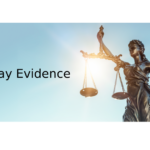High Court Rules that Police Interview is Inadmissible

Richard Filihia was armed with a bowie knife when he entered a brothel on the night of October 24 2012. He stabbed the establishment’s receptionist Brian Gaudry, before fleeing with the cash he’d taken from the man’s back pocket.
The receptionist subsequently died from his wounds.
On the street, Filihia was picked up by a man who had driven him to the brothel. Sarah Coffinson was sitting in the front passenger seat of the car.
The murder’s statements
Police apprehended Filihia on the same night. Back at the station, he made admissions to the murder during a electronically recorded police interview, or ‘ERISP’. He told police he had been driven to the brothel by a man named Jacob. At one point, he referred to this man as Dan, but then said he was mistaken.
Later that same evening, Filihia made a written statement in which he said Jacob had been driving the car, had given him the knife and told him where he could find money in the brothel. He said they had agreed to “split the money fifty-fifty.”
At no stage during the interview did Filihia mention the presence of Ms Coffinson in the car.
On the following day, Filihia identified Daniel Sio as the man who had been driving, from a photo array.
Filihia pleaded guilty to armed robbery with wounding and the murder of Gaudry in August 2013.
Sio’s trial
Daniel Sio stood trial at a later date on the same charges. Filihia was called to give evidence, but he refused to take an oath or affirmation, or answer any question about the matter. This was despite being told that he could face punishment for contempt of court.
The Crown sought to tender Filihia’s interview and statement as evidence, but Mr Sio’s legal team objected on the basis that it was hearsay evidence.
As explained in a previous blog, section 59 of the Evidence Act, known as the hearsay rule, provides that ‘evidence of a previous representation made by a person is not admissible to prove the existence of a fact that it can reasonably be supposed that the person intended to assert by the representation.’
In this case, Filihia’s statement to police was hearsay because it was made out of court and his refusal to testify made him ‘unavailable’ to give evidence in person and be subjected to cross-examination by the defence.
Admissibility of hearsay evidence if maker is unavailable
However, the trial judge, Justice Adamson, allowed the interview and statement to be admitted as evidence under an exception to the hearsay rule contained in section 65(2)(d) of the Evidence Act.
That section says the hearsay rule does not apply to evidence of a previous representation that is given by a person who saw, heard or otherwise perceived the representation being made, if the representation:
(a) was made under a duty to make that representation or to make representations of that kind, or
(b) was made when or shortly after the asserted fact occurred and in circumstances that make it unlikely that the representation is a fabrication, or
(c) was made in circumstances that make it highly probable that the representation is reliable, or
(d) was:
(i) against the interests of the person who made it at the time it was made, and
(ii) made in circumstances that make it likely that the representation is reliable.
The judge in the present case found that Filihia’s interview was permissible because, firstly, the statements made therein were reliable due to the Filihia’s demeanour during the interview, which was deemed guileless, courteous and willing, and secondly, were not in Filihia’s best interests.
The jury subsequently found Sio not guilty of murder, but guilty of armed robbery with wounding. He was convicted and sentenced to 10 years imprisonment, with a non-parole period of 7 and a half years.
NSW Court of Criminal Appeal (NSWCCA)
Mr Sio appealed his conviction to the NSWCCA in 2015, on the basis that the interview and statements therein should not have been admitted into evidence. It was also argued that the conviction for armed robbery with wounding was unreasonable due to its inconsistency with the acquittal for murder.
Justice Leeming of the NSWCCA remarked that the question was not whether the statements themselves were “accurate or likely reliable”, but whether the circumstances in which they were made were “likely to be reliable.”
The court ultimately dismissed Sio’s appeal on the basis that the statements had been made in circumstances that rendered them likely to be reliable. This was primarily because Filihia made the statements within 24 hours of the incident, when the events were fresh in his memory, and they appeared to be unrehearsed.
High Court
But the High Court of Australia unanimously allowed Sio’s appeal on March 11 last year. The justices were critical of the approach taken by both the trial judge and the NSWCCA whereby an “overall impression” was formed as to the reliability of a co-offender’s (Filihia’s) statements.
The highest court in the land warned against making an “impressionistic evaluation” of evidence in assessing its reliability in the context of section 65(2)(d).
The court noted that evidence provided by an accomplice was a category well-known to be less than reliable due to the risk of falsification, given the incentive for a co-offender to shift the blame away from themselves.
The court found that the statements as to who had provided the knife and put Filihia up to the robbery were given by Filihia under circumstances where it was advantageous for him to lower his culpability and maximise Sio’s.
As Filihia was Sio’s accomplice, the court held there was a chance for a high level of unreliability in the circumstances in which the statements were made. The justices found there was no reason to have made a positive finding of the likely reliability of the evidence, which ought not to have been admitted.
A retrial ordered
The High Court further found that the trial judge’s directions on the armed robbery with wounding charge were wrong, as there was no proof that he had expected his accomplice to actually use the weapon during the robbery.
As to the argument that the conviction for armed robbery with wounding was unreasonable because it was inconsistent with Sio’s acquittal for murder, the High Court accepted Sio’s argument that the jury’s verdict could not be a merciful one.
The conviction of armed robbery with wounding was quashed. However, the High Court did not substitute it with a conviction of armed robbery, because it could not be satisfied that the jury – without the evidence of the statements – would have convicted him of this charge.
The appropriate remedy for this miscarriage of justice, the High Court found, was that Sio be retried on a charge of armed robbery.








